Assessing the Impacts of Land-Use Zoning Decisions on the Supply of Forest Ecosystem Services
Abstract
1. Introduction
2. Materials and Methods
2.1. Study Areas and Field Data
2.2. Conservation Areas and Regional Land Use Plans
2.3. Modeling Forest Scenarios
2.4. Calculation of Indicators
3. Results
3.1. Effects on Wood Production
3.2. Effects on Carbon Stock
3.3. Effects on Bilberry and Cowberry Yields
3.4. Effect on Scenic Beauty and Recreation Values
3.5. Synthesis of the Effects at Country Level
4. Discussion
4.1. Impacts of Land-Use Zoning Decisions on Ecosystem Services from Forests
4.2. Evaluation of the Method
5. Conclusions
Author Contributions
Funding
Acknowledgments
Conflicts of Interest
Availability of Data and Material
References
- The European Parliament and the Council of European Union. Renewable Energy Directive 2018/2001/EU. Off. J. Eur. Union 2018, 5, 82–209. Available online: https://eur-lex.europa.eu/legal-content/EN/TXT/?uri=CELEX%3A32018L2001 (accessed on 11 August 2020).
- Alberdi, I.; Michalak, R.; Fischer, C.; Gasparini, P.; Brändli, U.-B.; Tomter, S.M.; Kuliesis, A.; Snorrason, A.; Redmond, J.; Hernández, L.; et al. Towards harmonized assessment of European forest availability for wood supply in Europe. For. Policy Econ. 2016, 70, 20–29. [Google Scholar] [CrossRef]
- Millennium Ecosystem Assessment. Ecosystem and Human Well-being. In Synthesis; Island Press: Washington, DC, USA, 2015; Available online: https://www.millenniumassessment.org/documents/document.356.aspx.pdf (accessed on 11 April 2020).
- EC. EU Biodiversity Action Plan. Halting the Loss of Biodiversity by 2010—And Beyond—Sustaining Ecosystem Services for Human Well-Being. 2016. Available online: http://ec.europa.eu/environment/nature/biodiversity/comm2006/index_en.htm (accessed on 4 May 2020).
- EC. Our Life Insurance, Our Natural Capital: An EU Biodiversity Strategy to 2020. COM(2011) 244 Final. 2011. Available online: http://eur-lex.europa.eu/legal-content/EN/TXT/?uri=CELEX:52011DC0244 (accessed on 4 May 2020).
- Forest Europe; UNECE; FAO. State of Europe’s Forests 2011. Status and Trends in Sustainable Forest Management in Europe. 2011. Available online: https://www.foresteurope.org/documentos/State_of_Europes_Forests_2011_Report_Revised_November_2011.pdf (accessed on 5 May 2020).
- EC. A New Forest Strategy: For Forests and the Forest-Based Sector. COM(2013) 659 Final. 2013. Available online: https://eur-lex.europa.eu/resource.html?uri=cellar:21b27c38-21fb-11e3-8d1c-01aa75ed71a1.0022.01/DOC_1&format=PDF (accessed on 4 May 2020).
- Forest Europe. State of Europe’s Forests 2015. 2015. Available online: https://www.foresteurope.org/docs/fullsoef2015.pdf (accessed on 5 May 2020).
- Natural Resources Institute Finland. Statistics Database: Protected Areas, Biodiversity Conservation Sites in Commercial Forests, and Areas Supporting Conservation of Nature Values, by Region (1000 ha). 2019. Available online: http://statdb.luke.fi/PXWeb/pxweb/en/LUKE/LUKE__04%20Metsa__02%20Rakenne%20ja%20tuotanto__04%20Metsien%20suojelu/02_metsien-suojelu.px/?rxid=001bc7da-70f4-47c4-a6c2-c9100d8b50db (accessed on 18 April 2020).
- Kangas, A.; Saarinen, N.; Saarikoski, H.; Leskinen, L.A.; Hujala, T.; Tikkanen, J. Stakeholder perspectives about proper participation for Regional Forest Programmes in Finland. For. Policy Econ. 2010, 12, 213–222. [Google Scholar] [CrossRef]
- UN. The 2030 Agenda for Sustainable Development. 2018. Available online: https://sustainabledevelopment.un.org/?menu=1300 (accessed on 6 May 2020).
- Government Decision on Finland’s National Land Use Guidelines. 2017. Available online: https://www.ym.fi/download/noname/%7BC8DAA05E-FBC8-490E-A805-37BCE01A1E43%7D/138177 (accessed on 5 May 2020).
- Land Use and Building Act. Maankäyttö- ja Rakennuslaki 5.2.1999/132. Available online: https://www.finlex.fi/en/laki/kaannokset/1999/en19990132.pdf (accessed on 28 February 2020).
- Nuutinen, T.; Kilpeläinen, A.; Hirvelä, H.; Härkönen, K.; Ikonen, V.-P.; Lempinen, R.; Peltola, H.; Wilhelmsson, L.; Kellomäki, S. Future wood and fiber resources in the region of North Karelia. Silva Fenn. 2009, 43, 489–505. [Google Scholar] [CrossRef][Green Version]
- Barreiro, S.; Schelhaas, M.J.; Kändler, G.; Antón-Fernandéz, C.; Colin, A.; Bontemps, J.D.; Alberdi, I.; Condés, S.; Dumitru, M.; Ferezliev, A.; et al. Overview of methods and tools for evaluating future woody biomass availability in European countries. Ann. For. Sci. 2016, 73, 823–837. [Google Scholar] [CrossRef]
- Kärkkäinen, L.; Haakana, H.; Hirvelä, H.; Packalen, T. Using a decision support system to study impacts of land use policies on wood procurement possibilities of the sawmill industry—A case study at regional and municipal levels. For. Policy Econ. 2019, 103, 136–146. [Google Scholar] [CrossRef]
- Siitonen, M. Experiences in the use of forest management planning models. Silva Fenn. 1993, 27, 167–178. [Google Scholar] [CrossRef]
- Jonsson, B.; Jacobsson, J.; Kallur, H. The Forest Management Planning Package. Theory and Application; Studia Forestalia Suecica: Huddersfield, UK, 1993; Volume 189, 56p, ISBN 91-576-4698-8. [Google Scholar]
- Eid, T.; Hobbelstad, K. AVVIRK-2000: A Large-scale Forestry Scenario Model for Long-term Investment, Income and Harvest Analyses. Scand. J. For. Res. 2000, 15, 472–482. [Google Scholar] [CrossRef]
- Eid, T.; Hoen, H.F.; Økseter, P. Timber production possibilities of the Norwegian forest area and measures for a sustainable forestry. For. Policy Econ. 2002, 4, 187–200. [Google Scholar] [CrossRef]
- Eriksson, L.O.; Sallnäs, O.; Ståhl, G. Forest certification and Swedish wood supply. For. Policy Econ. 2007, 9, 452–463. [Google Scholar] [CrossRef]
- Nuutinen, T.; Hirvelä, H.; Hynynen, J.; Härkönen, K.; Hökkä, H.; Korhonen, K.T.; Salminen, O. The role of peatlands in Finnish wood production—An analysis based on large-scale forest scenario modelling. Silva Fenn. 2000, 34, 131–153. [Google Scholar] [CrossRef]
- Wikström, P.; Edenius, L.; Elfving, B.; Eriksson, L.O.; Lämås, T.; Sonesson, J.; Öhman, K.; Wallerman, J.; Waller, C.; Klintebäck, F. The Heureka Forestry Decision Support System: An overview. Math. Comput. For. Nat. Resour. Sci. 2011, 3, 87–94. [Google Scholar]
- Kline, J.D.; Harmon, M.E.; Spies, T.A.; Morzillo, A.T.; Pabst, R.J.; McComb, B.C.; Schnekenburger, F.; Olsen, K.A.; Csuti, B.; Vogeler, J.C. Evaluating carbon storage, timber harvest, and habitat possibilities for a Western Cascades (USA) forest landscape. Ecol. Appl. 2016, 26, 1–16. [Google Scholar] [CrossRef] [PubMed]
- Pukkala, T. Which type of forest management provides most ecosystem services? For. Ecosyst. 2016, 3, 9. [Google Scholar] [CrossRef]
- Heinonen, T.; Pukkala, T.; Mehtätalo, L.; Asikainen, A.; Kangas, J.; Peltola, H. Scenario analyses for the effects of harvesting intensity on development of forest resources, timber supply, carbon balance and biodiversity of Finnish forestry. For. Policy Econ. 2017, 80, 80–98. [Google Scholar] [CrossRef]
- Eggers, J.; Holmgren, S.; Nordström, E.-M.; Lämås, T.; Lind, T.; Öhman, K. Balancing different forest values: Evaluation of forest management scenarios in a multi-criteria decision analysis framework. For. Policy Econ. 2019, 103, 55–69. [Google Scholar] [CrossRef]
- Eyvindson, K.; Repo, A.; Mönkkönen, M. Mitigating forest biodiversity and ecosystem service losses in the era of biobased economy. For. Policy Econ. 2018, 92, 119–127. [Google Scholar] [CrossRef]
- Vauhkonen, J.; Packalen, T. Shifting from even-aged management to less intensive forestry in varying proportions of forest land in Finland: Impacts on carbon storage, harvest removals, and harvesting costs. Eur. J. For. Res. 2019, 138, 219–238. [Google Scholar] [CrossRef]
- de Groot, R.S.; Alkemade, R.; Braat, L.; Hein, L.; Willemen, L. Challenges in integrating the concept of ecosystem services and values in landscape planning, management and decision making. Ecol. Complex. 2010, 7, 260–272. [Google Scholar] [CrossRef]
- Muller, F.; Burkhard, B. The indicator side of ecosystem services. Ecosyst. Serv. 2012, 1, 26–30. [Google Scholar] [CrossRef]
- Layke, C.; Mapendembe, A.; Brown, C.; Walpole, M.; Winn, J. Indicators from the global and sub-global Millennium Ecosystem Assessments: An analysis and next steps. Ecol. Indic. 2012, 17, 77–87. [Google Scholar] [CrossRef]
- Hansen, K.; Malmaeus, M. Ecosystem services in Swedish forests. Scand. J. For. Res. 2016, 31, 626–640. [Google Scholar] [CrossRef]
- Mononen, L.; Auvinen, A.-P.; Ahokumpu, A.-L.; Rönkä, M.; Aarras, N.; Tolvanen, H.; Kamppinen, M.; Viirret, E.; Kumpula, T.; Vihervaara, P. National ecosystem service indicators: Measures of social-ecological sustainability. Ecol. Indic. 2016, 61, 27–37. [Google Scholar] [CrossRef]
- Haakana, H.; Hirvelä, H.; Hanski, I.K.; Packalen, T. Comparing regional forest policy scenarios in terms of predicted suitable habitats for the Siberian flying squirrel (Pteromys volans). Scand. J. For. Res. 2017, 32, 185–195. [Google Scholar] [CrossRef]
- Raitio, K.; Tikkanen, O.-P.; Heinonen, T.; Matero, J.; Kouki, J. Metsien käyttöskenaarioiden sosiaaliset vaikutukset. In Uhanalaisten Lahopuulajien Elinympäristöjen Turvaaminen Suojelualueilla ja Talousmetsissä. Kustannustehokkuus ja Ekologiset, Ekonomiset sekä Sosiaaliset Vaikutukset Kitsin Seudulla Lieksassa; Kouki, J., Tikkanen, O.-P., Eds.; Suomen Ympäristö: Helsinki, Finland, 2007; Volume 24, pp. 51–61. (In Finnish) [Google Scholar]
- Tikkanen, O.-P.; Heinonen, T.; Matero, J.; Kouki, J. Metsien käyttöskenaarioiden vaikutukset puuntuotantoon, virkistyskäyttöön ja lajien habitaatin määrään. In Uhanalaisten Lahopuulajien Elinympäristöjen Turvaaminen Suojelualueilla ja Talousmetsissä. Kustannustehokkuus ja Ekologiset, Ekonomiset sekä Sosiaaliset Vaikutukset Kitsin Seudulla Lieksassa; Kouki, J., Tikkanen, O.-P., Eds.; Suomen Ympäristö: Helsinki, Finland, 2007; Volume 24, pp. 44–50. (In Finnish) [Google Scholar]
- Frank, S.; Fürst, C.; Koschke, L.; Witt, A.; Makeschin, F. Assessment of landscape aesthetics—Validation of a landscape aesthetics—Validation of a landscape metrics-based assessment by visual estimation of the scenic beauty. Ecol. Indic. 2013, 32, 222–231. [Google Scholar] [CrossRef]
- Fürst, C.; Frank, S.; Witt, A.; Koschke, L.; Makeschin, F. Assessment of the effects of forest land use strategies on the provision of ecosystem services at regional scale. J. Environ. Manag. 2013, 127, 96–116. [Google Scholar] [CrossRef] [PubMed]
- Bennett, E.M.; Peterson, G.D.; Gordon, L.J. Understanding relationships among multiple ecosystem services. Ecol. Lett. 2009, 12, 1394–1404. [Google Scholar] [CrossRef]
- Räty, M.; Heikkinen, J.; Korhonen, K.T.; Peräsaari, J.; Ihalainen, A.; Pitkänen, J.; Kangas, A.S. Effect of cluster configuration and auxiliary variables on the efficiency of local pivotal method for national forest inventory. Scand. J. For. Res. 2019, 34, 607–616. [Google Scholar] [CrossRef]
- Valtakunnan Metsien 12. Inventointi (VMI12). In Maastotyön Ohjeet 2018; Koko Suomi ml. Ahvenanmaa; Luonnonvarakeskus: Moniste, Finland, 2018. (In Finnish) [Google Scholar]
- Laasasenaho, J. Taper Curves and Volume Functions for Pine, Spruce and Birch; Communicationes Instituti Forestalis Fenniae: Helsinki, Finland, 1982; Volume 108. [Google Scholar]
- Hirvelä, H.; Härkönen, K.; Lempinen, R.; Salminen, O. MELA2016 Reference Manual; Natural Resources Institute Finland: Helsinki, Finland, 2017; Volume 7, 547p, ISBN 978-952-326-1. [Google Scholar]
- Nature Conservation Act (1096/1996). Available online: https://finlex.fi/en/laki/kaannokset/1996/en19961096.pdf (accessed on 6 May 2020).
- Antiquities Act (295/1963). Muinaismuistolaki. Available online: https://www.finlex.fi/fi/laki/ajantasa/1963/19630295 (accessed on 6 May 2020). (In Finnish).
- Kärkkäinen, L.; Haakana, H.; Hirvelä, H.; Lempinen, R.; Packalen, T. Impact Assessment of Land Use Decisions on Wood Supply at Regional Level—Case Kainuu, Finland. Unpublished work. 2020.
- Mattila, U.; Korhonen, K.T. Yleiskaavamerkintöjen ja -määräysten aiheuttamat puuntuotannon rajoitukset Pohjois-Karjalassa valtakunnan metsien 10. inventoinnin mukaan. Metsätieteen Aikakauskirja 2010, 1, 5–18. (In Finnish) [Google Scholar] [CrossRef][Green Version]
- Forest Act (1093/1996). Available online: https://finlex.fi/fi/laki/kaannokset/1996/en19961093_20140567.pdf (accessed on 5 May 2020).
- Siitonen, M.; Härkönen, K.; Hirvelä, H.; Jämsä, J.; Kilpeläinen, H.; Salminen, O.; Teuri, M. MELA Handbook–1996 Edition; Research Papers’; The Finnish Research Institute: Helsinki, Finland, 1996; Volume 622, 452p, Available online: http://urn.fi/URN:ISBN:951-40-1543-6 (accessed on 18 August 2020).
- The Forest 2000 Programme. Guidelines for Developing Finnish Forestry and the Forest Industries. Silva Fenn. 1985, 20, 35–44.
- Nuutinen, T.; Matala, J.; Hirvelä, H.; Härkönen, K.; Peltola, H.; Väisänen, H.; Kellomäki, S. Regionally optimized forest management under changing climate. Clim. Chang. 2006, 79, 315–333. [Google Scholar] [CrossRef]
- Mäkelä, H.; Hirvelä, H.; Nuutinen, T.; Kärkkäinen, L. Estimating forest data for analyses of forest production and utilization possibilities at local level by means of multi-source National Forest Inventory. For. Ecol. Manag. 2011, 262, 1345–1359. [Google Scholar] [CrossRef]
- Ministry of Agriculture and Forestry, National Resources Institute Finland. National Forestry Accounting Plan for Finland; Submission of Updated National Forestry Accounting Plan Including Forest Reference Level (2021–2025) for Finland (20 December 2019); Ministry of Agriculture and Forestry, National Resources Institute Finland; 76p, Available online: https://www.luke.fi/wp-content/uploads/2019/12/NFAP-for-Finland-20-December-2019.pdf (accessed on 11 August 2020).
- Lappi, J. JPL: A Linear Programming Package for Management Planning; Research Papers; The Finnish Forest Research Institute: Suonenjoki, Finland, 1992; Volume 414. [Google Scholar]
- Hynynen, J.; Ojansuu, R.; Hökkä, H.; Siipilehto, J.; Salminen, H.; Haapala, P. Models for Predicting Stand Development in MELA System; Research Papers; The Finnish Forest Research Institute: Vantaa, Finland, 2002; Volume 835, 116p. [Google Scholar]
- Äijälä, O.; Koistinen, A.; Sved, J.; Vanhatalo, K.; Väisänen, P. Metsänhoidon Suositukset; Metsätalouden Kehittämiskeskus Tapion Julkaisuja: Helsinki, Finland, 2014. (In Finnish) [Google Scholar]
- Koistinen, A.; Luiro, J.-P.; Vanhatalo, K. (Eds.) Metsänhoidon Suositukset Energiapuun Korjuuseen, Työopas; Tapion Julkaisuja: Helsinki, Finland, 2016; Available online: https://tapio.fi/wp-content/uploads/2015/06/MHS-Energiapuun-korjuun-suositukset_verkkojulkaisu2.pdf (accessed on 5 May 2020). (In Finnish)
- Salminen, O.; Hirvelä, H.; Härkönen, K. Valtakunnan metsien 10. inventointiin perustuvat ainespuun alueelliset hakkuumahdollisuusarviot. Metsätieteen Aikakauskirja 2013, 3, 199–268. (In Finnish) [Google Scholar] [CrossRef]
- Natural Resources Institute Finland. MELA Summary Reports 2020. Available online: https://www.luke.fi/mela-cutting-possibilities/ (accessed on 13 February 2020).
- Repola, J. Biomass equations for Birch in Finland. Silva Fenn. 2008, 42, 605–624. [Google Scholar] [CrossRef]
- Repola, J. Biomass equations for Scots pine and Norway spruce in Finland. Silva Fenn. 2009, 43, 625–647. [Google Scholar] [CrossRef]
- Penman, J.; Gytarsky, M.; Hiraishi, T.; Krug, T.; Kruger, D.; Pipatti, R.; Buendia, L.; Miwa, K.; Ngara, T.; Tanabe, K.; et al. (Eds.) Good Practice Guidance for Land Use, Land-Use Change and Forestry; IPCC National Greenhouse Gas Inventories Programme: Hayama, Japan, 2003; Available online: https://www.ipcc-nggip.iges.or.jp/public/gpglulucf/gpglulucf_files/GPG_LULUCF_FULL.pdf (accessed on 6 May 2020).
- Miina, J.; Hotanen, J.P.; Salo, K. Modelling the abundance and temporal variation in the production of bilberry (Vaccinium myrtillus L.) in Finnish mineral soil forests. Silva Fenn. 2009, 43, 181. [Google Scholar] [CrossRef]
- Turtiainen, M.; Miina, J.; Salo, K.; Hotanen, J.P. Empirical prediction models for the coverage and yields of cowberry in Finland. Silva Fenn. 2013, 47. [Google Scholar] [CrossRef]
- Kilpeläinen, H.; Salminen, O.; Härkönen, K.; Miina, J.; Kurttila, M. Integrating bilberry yields into regional long-term forest scenario analyses. Scand. J. For. Res. 2018, 33, 378–386. [Google Scholar] [CrossRef]
- Pukkala, T.; Kellomäki, S.; Mustonen, E. Prediction of the Amenity of a Tree Stand. Scand. J. For. Res. 1988, 3, 533–544. [Google Scholar] [CrossRef]
- Heinonen, T. Monitavoitteinen metsäsuunnittelu: Menetelmän yleisperiaatteet ja Kitsin-Hattuvaaran alueen erityispiirteet. In Uhanalaisten Lahopuulajien Elinympäristöjen Turvaaminen Suojelualueilla ja Talousmetsissä. Kustannustehokkuus ja Ekologiset, Ekonomiset sekä Sosiaaliset Vaikutukset Kitsin Seudulla Lieksassa; Kouki, J., Tikkanen, O.P., Eds.; Suomen Ympäristö: Helsinki, Finland, 2007; Volume 24, pp. 36–43. (In Finnish) [Google Scholar]
- State of Finland’s Forests. Based on the Criteria and Indicators of Sustainable Forest Management. 2012. Available online: http://www.metla.fi/metinfo/sustainability/ (accessed on 6 May 2020).
- Natural Resources Institute Finland. Statistics Database: Ownership of Forest Land (1000 ha). 2019. Available online: http://statdb.luke.fi/PXWeb/pxweb/en/LUKE/LUKE__04%20Metsa__06%20Metsavarat/1.07_Metsamaa_omistajaryhmittain.px/?rxid=001bc7da-70f4-47c4-a6c2-c9100d8b50db (accessed on 6 May 2020).
- Pohjanmies, T.; Triviño, M.; Le Tortorec, E.; Salminen, H.; Mönkkönen, M. Conflicting objectives in production forests pose a challenge for forest management. Ecosyst. Serv. 2017, 28, 298–310. [Google Scholar] [CrossRef]
- Verkerk, P.J.; Mavsar, R.; Giergiczny, M.; Lindner, M.; Edwards, D.; Schelhaas, M.J. Assessing impacts of intensified biomass production and biodiversity protection on ecosystem services provided by European forests. Ecosyst. Serv. 2014, 9, 155–165. [Google Scholar] [CrossRef]
- Pang, X.; Nordström, E.-M.; Böttcher, H.; Trubins, R.; Mörtberg, U. Trade-offs and synergies among ecosystem services under different forest management scenarios—The LEcA tool. Ecosyst. Serv. 2017, 28, 67–79. [Google Scholar] [CrossRef]
- Alrahahleh, L.; Ikonen, V.-P.; Kilpeläinen, A.; Torssonen, P.; Strandman, H.; Asikainen, A.; Kaurola, J.; Venäläinen, A.; Peltola, H. Effects of forest conservation and management on volume growth, harvested amount of timber, carbon stock, and amount of deadwood in Finnish boreal forests under changing climate. Can. J. For. Res. 2017, 47, 215–225. [Google Scholar] [CrossRef]
- Triviño, M.; Juutinen, A.; Mazziotta, A.; Miettinen, K.; Podkopaev, D.; Reunanen, P.; Mönkkönen, M. Managing a boreal forest landscape for providing timber, storing and sequestrating carbon. Ecosyst. Serv. 2015, 14, 179–189. [Google Scholar] [CrossRef]
- Matala, J.; Kärkkäinen, L.; Härkönen, K.; Kellomäki, S.; Nuutinen, T. Carbon sequestration in the growing stock of trees in Finland under different cutting and climate scenarios. Eur. J. For. Res. 2009, 128, 493–504. [Google Scholar] [CrossRef]
- Seely, B.; Welham, C.; Kimmins, H. Carbon sequestration in a boreal forest ecosystem: Results from the ecosystem simulation model, FORECAST. For. Ecol. Manag. 2002, 169, 123–135. [Google Scholar] [CrossRef]
- Niemelä, J.; Saarela, S.-R.; Söderman, T.; Kopperoinen, L.; Yli-Pelkonen, V.; Väre, S.; Kotze, D.J. Using the ecosystem services approach for better planning and conservation of urban green spaces: A Finland case study. Biodivers. Conserv. 2010, 19, 3225–3243. [Google Scholar] [CrossRef]
- Biber, P.; Borges, J.G.; Moshammer, R.; Barreiro, S.; Botequim, B.; Brodrechtová, Y.; Brukas, V.; Chirichi, G.; Cordero-Debets, R.; Corrigan, E.; et al. How Sensitive Are Ecosystem Services in European Forest Landscapes to Silvicultural Treatment? Forests 2015, 6, 1666–1695. [Google Scholar] [CrossRef]
- Sandström, O.; Vaara, I.; Heikkuri, P.; Jokinen, M.; Kokkoniemi, T.; Liimatainen, J.; Loikkanen, T.; Mela, M.; Osmonen, O.; Salmi, J.; et al. Ylä-Lapin luonnonvarasuunnitelma. Metsähallituksen Metsätalouden Julk. 2000, 38, 246. Available online: https://julkaisut.metsa.fi/assets/pdf/mt/mt38-1.pdf (accessed on 6 May 2020). (In Finnish).
- Saarela, P. Selvitys Ylä-Lapin Metsä- ja Porotalouden Yhteensovittamisesta; Työryhmämuistio MMM, 2003; Volume 15, 55p, Available online: https://julkaisut.valtioneuvosto.fi/bitstream/handle/10024/160546/trm%202003_15_Selvitys%20Yl%C3%A4-Lapin%20mets%C3%A4-%20ja%20porotalouden%20yhteensovittamisesta.pdf?sequence=1&isAllowed=y (accessed on 6 May 2020). (In Finnish)
- Lapin Metsäohjelma 2012–2015 Metsäkeskus Lappi. 2012. Available online: https://www.metsakeskus.fi/sites/default/files/lapin-metsaohjelma-2012-2015.pdf (accessed on 6 May 2020). (In Finnish).
- Silvennoinen, H.; Pukkala, T.; Tahvanainen, L. Effect of Cuttings on the Scenic Beauty of a Tree Stand. Scand. J. For. Res. 2002, 17, 263–273. [Google Scholar] [CrossRef]
- Hyppönen, M. Lapin metsätalouden erityispiirteet. Metsätieteen Aikakauskirja 2002, 4. (In Finnish) [Google Scholar] [CrossRef][Green Version]
- Pukkala, T. Metsäsuunnittelun Perusteet; Joen Forest Program Consulting Ay: Joensuu, Finland, 1994. (In Finnish) [Google Scholar]
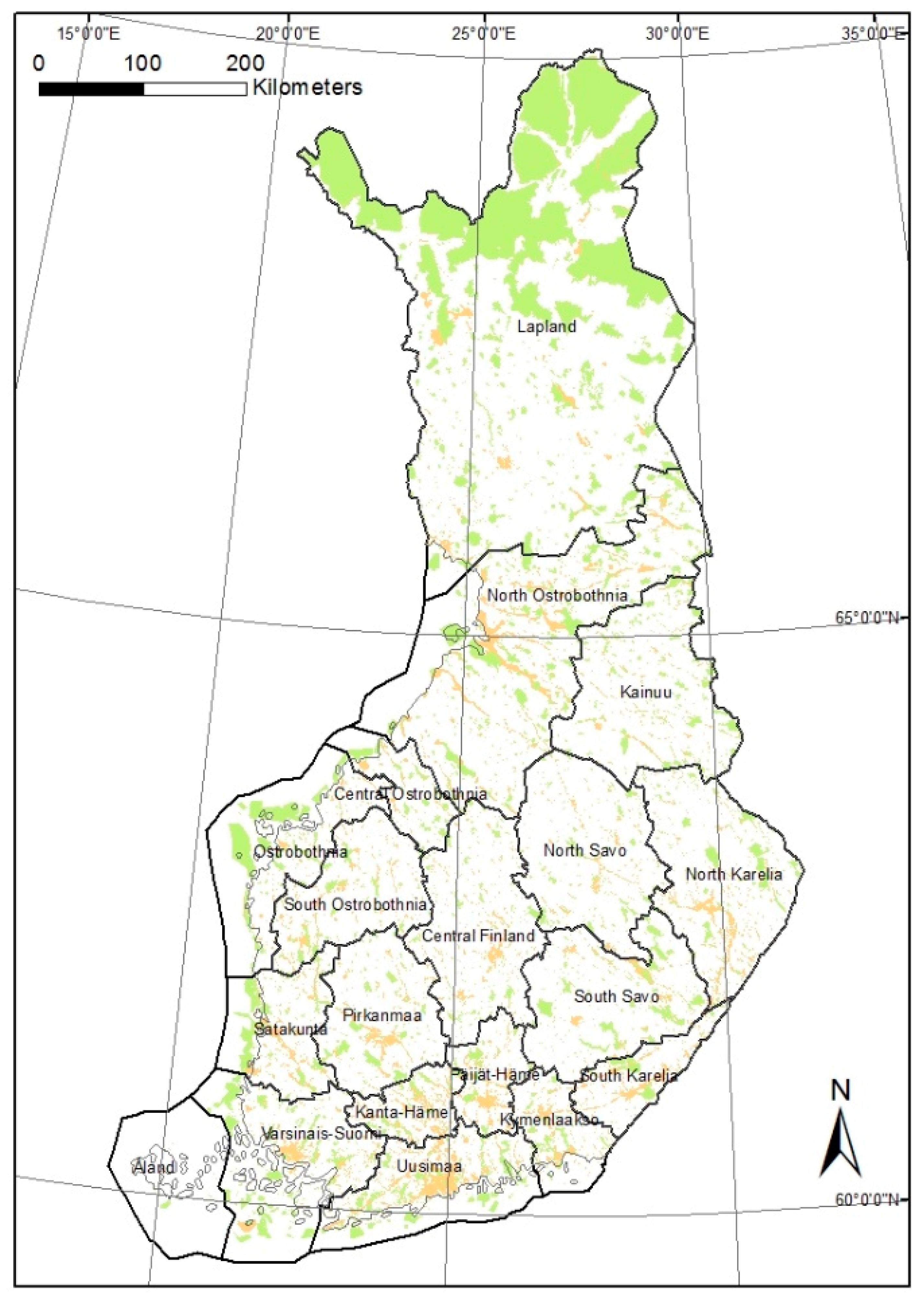

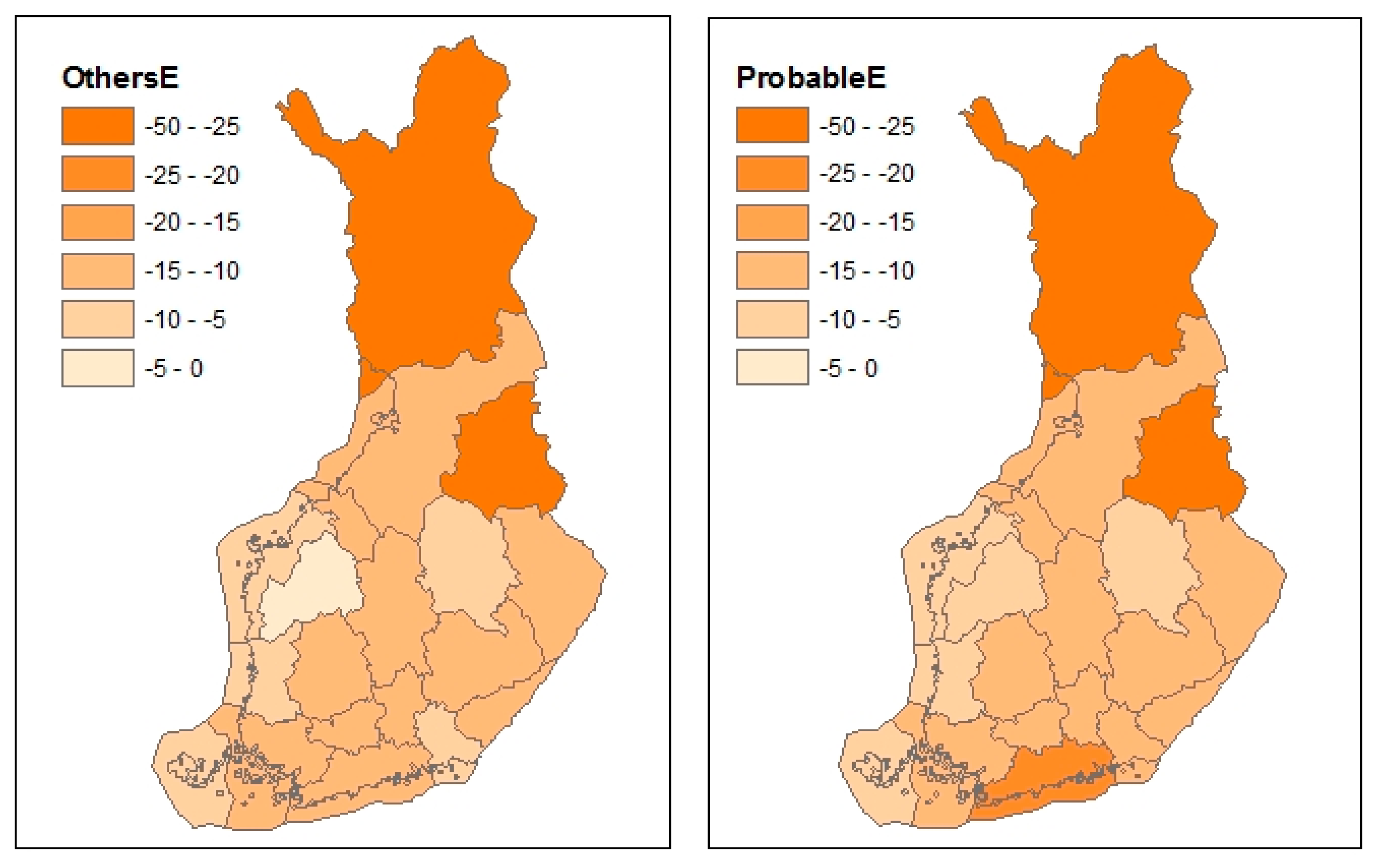
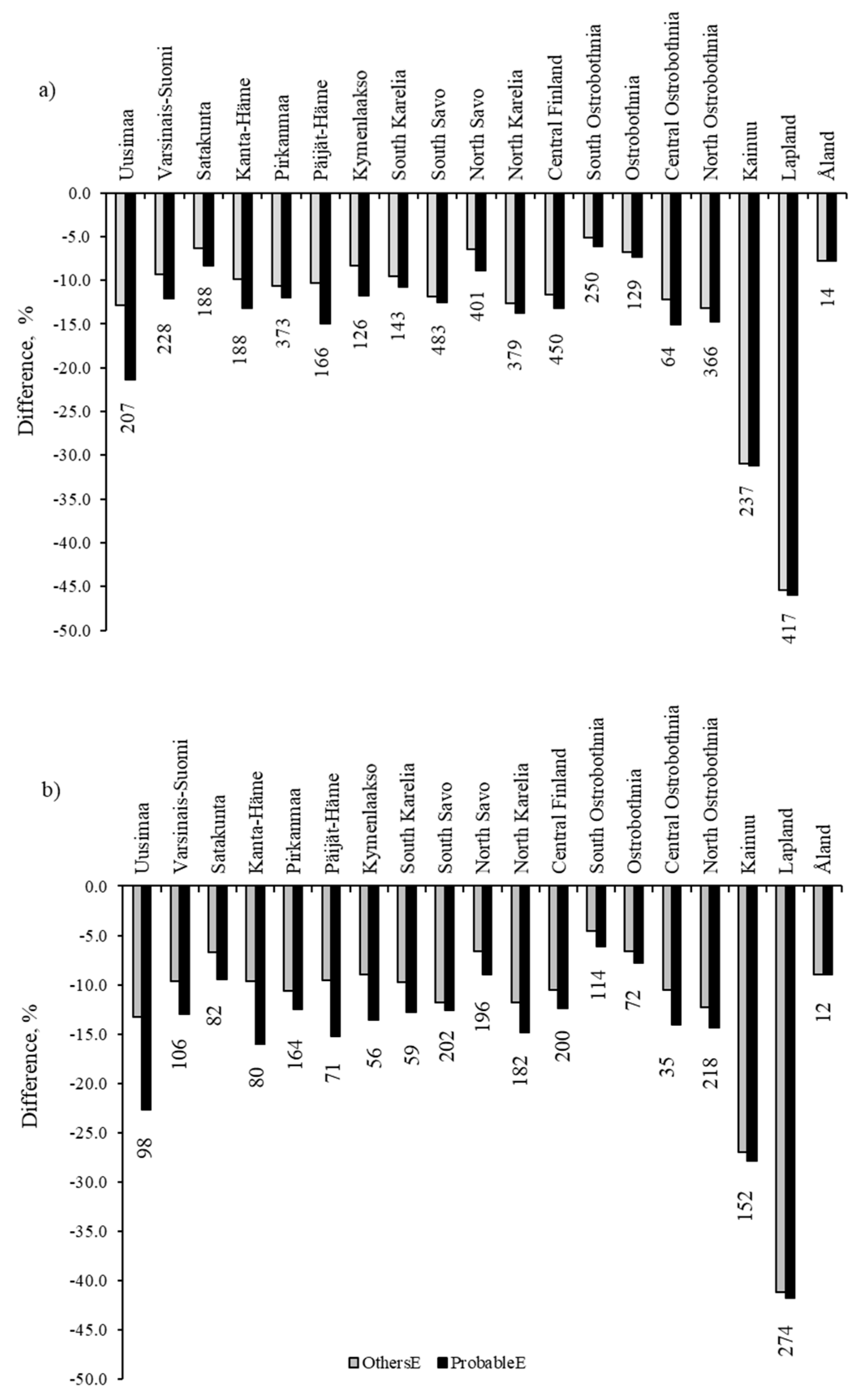
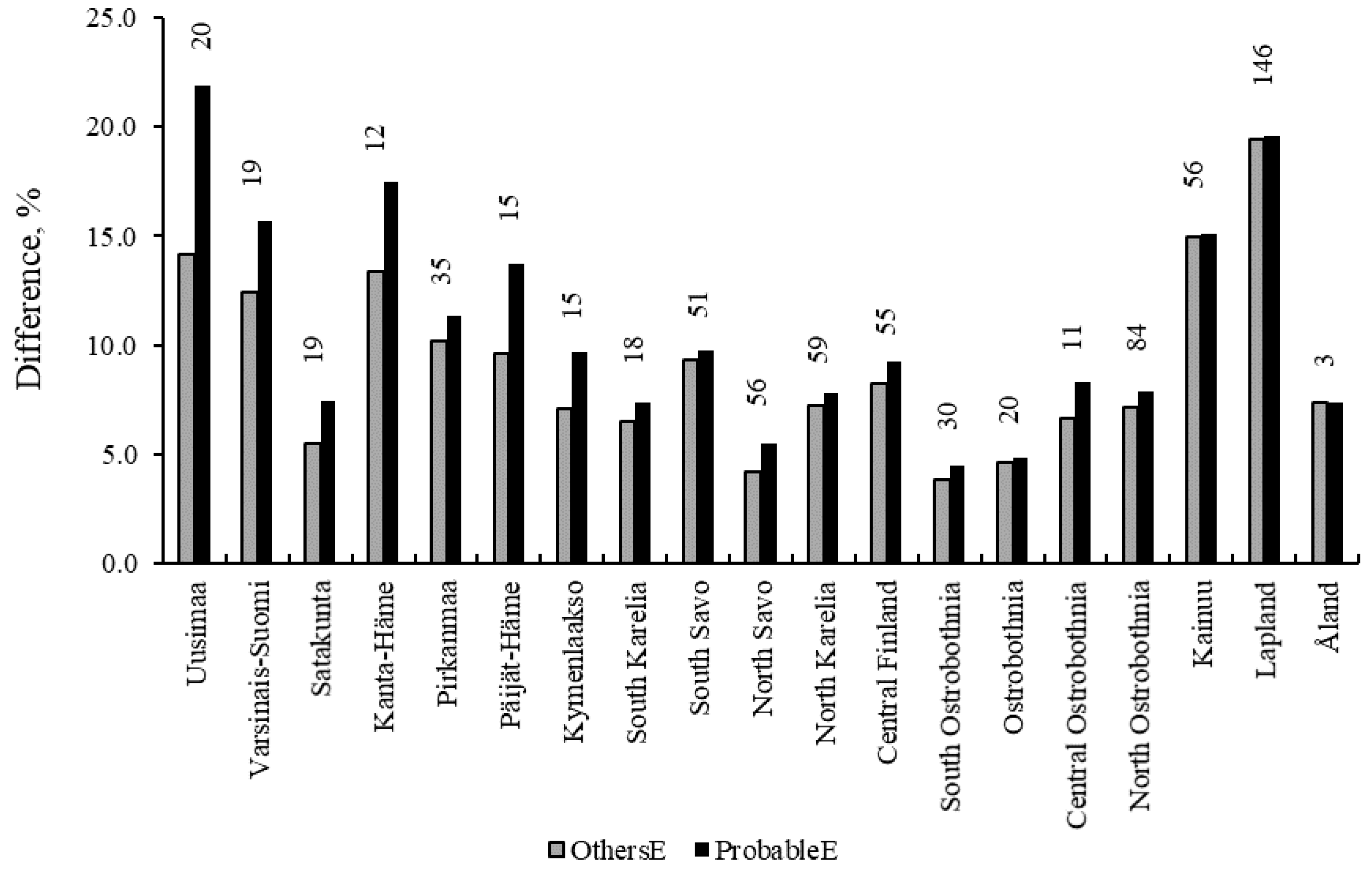
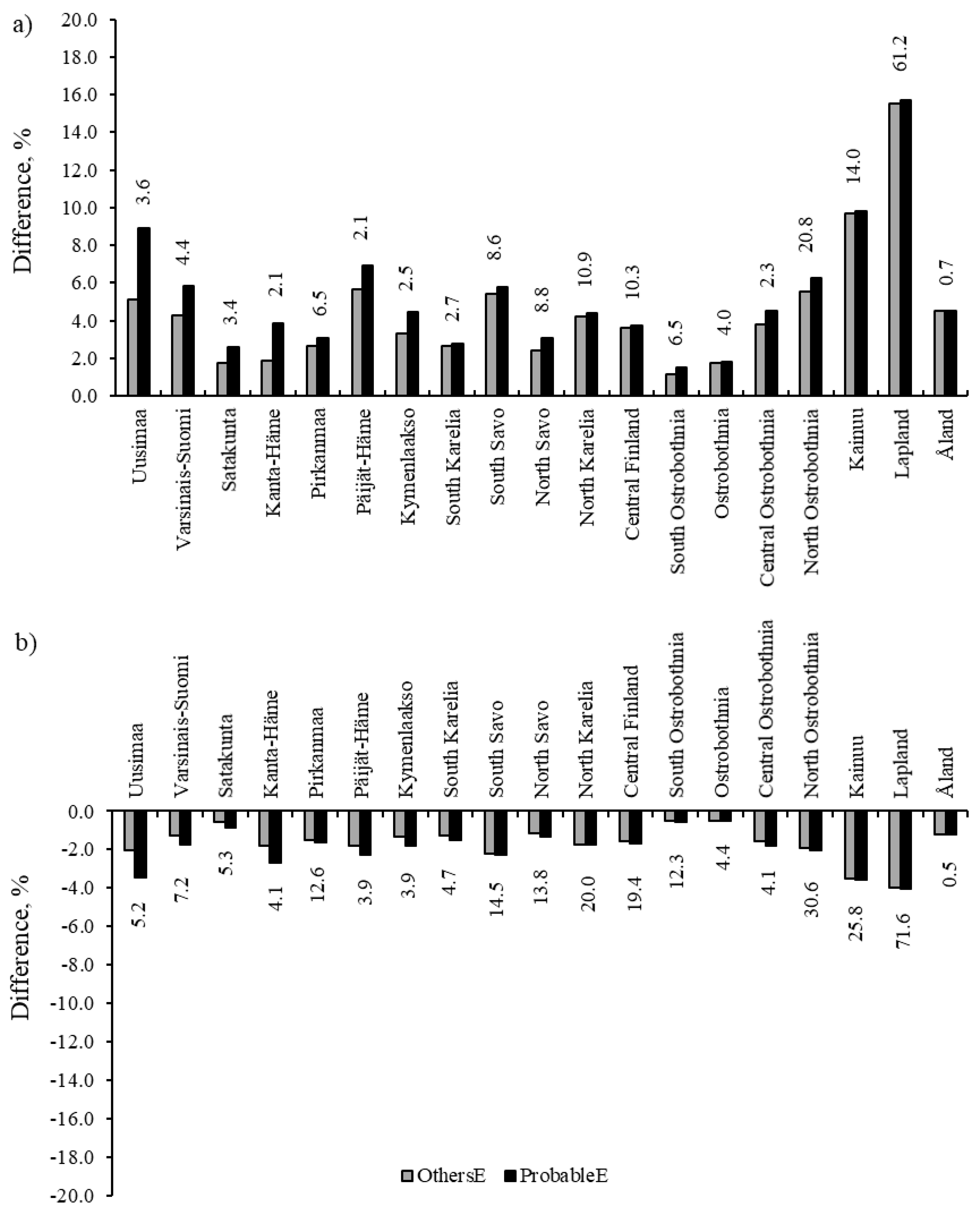
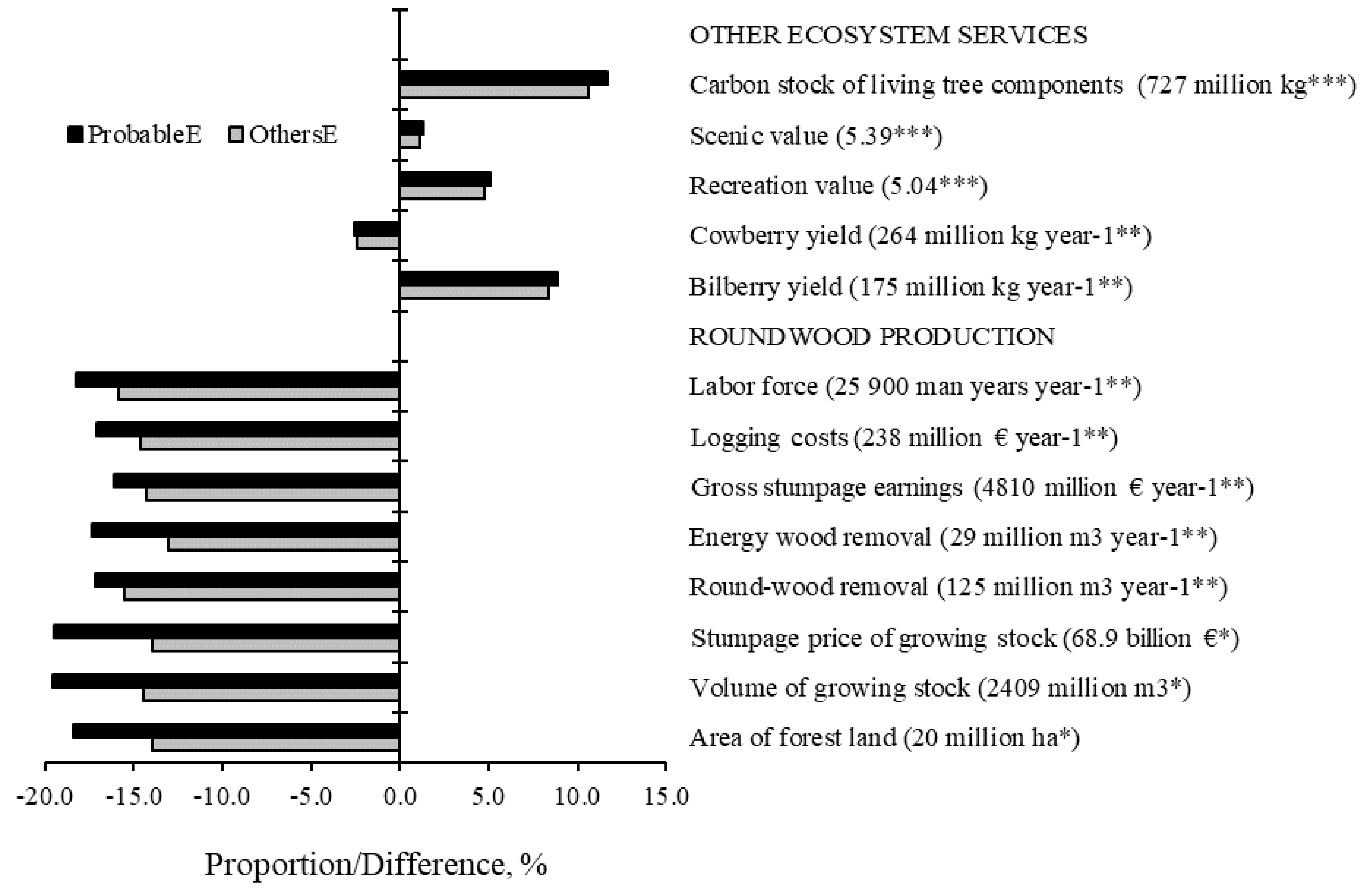
| Variable | Provinces | Finland | |||
|---|---|---|---|---|---|
| Mean | Std Dev | Min | Max | ||
| Total area (km2) | 20,574 | 21,395 | 5708 | 100,370 | 390,908 |
| Land area (km2) | 15,996 | 20,224 | 1554 | 92,676 | 303,906 |
| Forest land area (km2) | 10,672 | 11,195 | 639 | 49,618 | 202,764 |
| Poorly productive forest land (km2) | 1334 | 3876 | 20 | 16,957 | 25,355 |
| Forested land area (km2) | 12,006 | 14,817 | 886 | 66,575 | 228,119 |
| Total volume (million m3) | 130 | 97 | 12 | 417 | 2475 |
| Mean volume (m3 ha−1) | 139 | 26 | 75 | 163 | 119 |
| Proportion of pine (%) | 48 | 12 | 27 | 64 | 50 |
| Proportion of spruce (%) | 32 | 10 | 18 | 53 | 30 |
| Proportion of birch (%) | 16 | 2 | 9 | 19 | 17 |
| Proportion of other deciduous trees (%) | 4 | 2 | 1 | 9 | 3 |
| Zone | Management Category | Restrictions on Forest Management |
|---|---|---|
| Areas based on the Nature Conservation Act (1096/1996) | ||
| - Nature parks and nature reserves | Forest management not allowed | |
| - Mire reserves, herb-rich forest reserves, old-growth forest reserves and nature reserves on private land | Forest management not allowed | |
| - Natural habitats (based on this Act) | Forest management not allowed | |
| - Natura 2000 sites (based on this Act) | Forest management not allowed | |
| Other areas based on legislation | ||
| - Wilderness areas | Forest management not allowed | |
| - Special protection areas | Forest management not allowed | |
| - Habitats of protected species | Restricted management | Clear-felling not allowed |
| - National hiking areas | Restricted management | Clear-felling not allowed |
| - Ancient relic sites | Restricted management | Soil preparation and ditching not allowed |
| Areas reserved for protection | ||
| - Nature conservation programs for mires, herb-rich forests, old-growth forests, development of national and nature parks | Forest management not allowed | |
| - Nature conservation programs for shore areas and bird wetlands | Restricted management | Clear-felling not allowed |
| - Other areas reserved for conservation | Forest management not allowed | |
| Areas based on owners’ decision | ||
| - Forest protected by Metsähallitus (state-owned company that administers the state-owned land) | Forest management not allowed | |
| - Natural sites originating from the landscape ecological planning of Metsähallitus and other special areas | Restricted management | Clear-felling not allowed |
| - Other protected areas and areas of restricted use | Restricted management | Clear-felling not allowed |
| - Forest tree improvement, research forests | Restricted management | Clear-felling not allowed |
| - Temporary protection areas on private land | Forest management not allowed | |
| Other areas | ||
| - Other values recorded for NFI sample plots that have effects on forestry (e.g., landscape values, forest near the shore, forests near the settlement) | Restricted management | Clear-felling not allowed |
| Codes of regional land use plans | ||
| E (1) | Forest management allowed | |
| M (2) | Forest management allowed | |
| MU, MY (3) | Forest management allowed | |
| S, SL (4) | Forest management not allowed | |
| SM (5) | Restricted management | Soil preparation not allowed |
| SR (6) | Restricted management | Clear-felling not allowed |
| V, R (7) | Restricted management | Clear-felling not allowed |
| Other plan symbols | Restricted management | Clear-felling not allowed |
| ma (8) | Forest management allowed | |
| pv (9) | Restricted management | Ditching not allowed |
© 2020 by the authors. Licensee MDPI, Basel, Switzerland. This article is an open access article distributed under the terms and conditions of the Creative Commons Attribution (CC BY) license (http://creativecommons.org/licenses/by/4.0/).
Share and Cite
Kärkkäinen, L.; Haakana, H.; Hirvelä, H.; Lempinen, R.; Packalen, T. Assessing the Impacts of Land-Use Zoning Decisions on the Supply of Forest Ecosystem Services. Forests 2020, 11, 931. https://doi.org/10.3390/f11090931
Kärkkäinen L, Haakana H, Hirvelä H, Lempinen R, Packalen T. Assessing the Impacts of Land-Use Zoning Decisions on the Supply of Forest Ecosystem Services. Forests. 2020; 11(9):931. https://doi.org/10.3390/f11090931
Chicago/Turabian StyleKärkkäinen, Leena, Helena Haakana, Hannu Hirvelä, Reetta Lempinen, and Tuula Packalen. 2020. "Assessing the Impacts of Land-Use Zoning Decisions on the Supply of Forest Ecosystem Services" Forests 11, no. 9: 931. https://doi.org/10.3390/f11090931
APA StyleKärkkäinen, L., Haakana, H., Hirvelä, H., Lempinen, R., & Packalen, T. (2020). Assessing the Impacts of Land-Use Zoning Decisions on the Supply of Forest Ecosystem Services. Forests, 11(9), 931. https://doi.org/10.3390/f11090931




